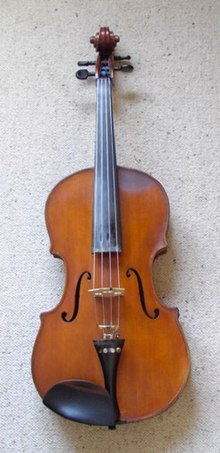Viola
The viola is rather similar to the violin, but the body of the instrument is slightly larger and the tone is more mellow. While the viola may not appear in the limelight as often as the violin, it plays an important but subtle part in any musical ensemble, countering the melodies with its richer, deeper harmonies.

History of the Viola
editClassical Periods
editViolas endured a long period of near-muteness during the Baroque period (1600-1750). Composers felt that the instrument was awkward and clumsy. During the 1800's, however, classical musicians such as Berlioz recognised the muscial value violas offered orchestras and composed many viola solos.
Playing the viola
editRudiments
editGood posture is as important for the viola as it is for the violin. The bow is held in the right hand, the viola in the left. The fingers should be curled gently over the top of the neck of the instrument.
Strings of the Viola
editThe strings of the viola are tuned to perfect fifths - from highest to lowest, A, D, G and C, which are an octave higher than the strings on the cello.
Fingering
edit- First finger - index finger
- Second finger - middle finger
- Third finger - ring finger
- Fourth finger - little finger
Positions
editThe first basic three notes upon a single string, using the first, second and third fingers make up first position, e.g. E, F#, and G on the D string. If the hand moves up one note, so that the first finger is now on F#, this is called second position, and so on. Positions aid the violist in reaching higher notes upon the string, or using vibrato on what usually would have to be an open string. There are eight positions in total.
Bowing
editThe bow should be drawn so that it is approximately parallel to the bridge. Beginner violists should practise bowing clear, resonant notes - making sure that they are not bowing two notes at the same time. Violists need to bow more firmly than violinists, given the thickness of the strings.
Practice Techniques
editBeginner violists should remember that solid improvement is easily achievable with regular practice. Twenty minutes a day, five days a week, is a good way to start. Remember, these sessions need to be lengthened with the difficulty of the playing standard.
Links
edit
This page was requested at Wikiversity:Requests